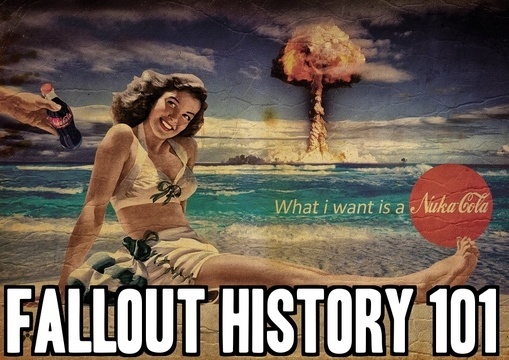This Fallout History is all about the iconic collectables and consumables that make the Wasteland fun. For a complete list of the 101’s: Here is a hub page to aid your curiosity.
The oldest of these is Sunset Sarsaparilla
Sunset Sasparilla is the Nuka-Cola cousin of the Mohave. However, the lore behind it (like a lot of Fallout lore) is somewhat conflicting. Festus, a robot in the Sunset Sarsaparilla factory, tells us that its an old family recipe. His story:
A saloon owner one day decided to make a new type of soft drink. He asked his customers what flavor they would want it to be, but they were of no help. A stranger at the end of the bar suggested him to make a sarsaparilla flavored drink, and would give his family’s recipe to the saloon owner if he got to sample a bottle to make sure the recipe was being followed to the letter. The saloon owner agreed, thinking it would make him rich. The stranger then left to meet him the next day at sundown. The following day, the saloon owner was told by the sheriff that the stranger was killed by bandits on the side of the town road. Cursing his luck, the saloon owner closed his store early, just as the sun began to set. After he locked the doors, he found a bottle with a note under it sealed with blue wax in the shape of a star. Opening it, he found out that it was a recipe of a sarsaparilla-flavored drink. After sampling the contents of the bottle, and finding it singularly delicious, he began selling Sunset Sarsaparilla. However, this is likely to be largely a promotional story which may only have a hint of truth in it.
The conflicting part of the story is when Festus tells us that the favorite beverages at the time were Nuka-Cola and water.
Which brings us to Nuka-Cola-
 -which wasn’t founded until 2044. By far the most popular drink before and after the war, Nuka-Cola tried out several variants like most soda companies do. 33 years after the original, Nuka-Cola quantum hit shelves. It advertised as having twice as much of everything: Taste, calories, sugar, and caffeine. To make it stand out, a radioactive isotope gave it the wonderful blue color it maintains in the wasteland. The blue color was decided after 86 out of 100 people polled said they liked the blue bottle better. Also, it turns your urine blue.
-which wasn’t founded until 2044. By far the most popular drink before and after the war, Nuka-Cola tried out several variants like most soda companies do. 33 years after the original, Nuka-Cola quantum hit shelves. It advertised as having twice as much of everything: Taste, calories, sugar, and caffeine. To make it stand out, a radioactive isotope gave it the wonderful blue color it maintains in the wasteland. The blue color was decided after 86 out of 100 people polled said they liked the blue bottle better. Also, it turns your urine blue.
Nuka-Cola Clear was next to replace Quantum. Because Quantum had questionable side-affects, Nuka-Cola decided to soften the blow with Clear and advertised it to only cause “a minimal loss of life.” However, this version never made it to the shelves.
Then you have Nuka-Cola Quartz, only found in the Mohave, that gave drinkers “low-light sight”. And finally Nuka-Cola Victory, also in the Mohave, that seemed pretty tame compared to its precessors due to “normal” side effects.
Hubris Comics
 Going backwards a bit, Hubris Comics published 14 issues of Grognak the Barbarian (akin to Conan the Barbarian) in 2021. The pre-war series is considered to be very rare and worth a whole 23 caps. Hubris Comics published several comics found in the Fallout universe, such as Tæles of Chivalrie, although Grognak was by the most influential and prevalent. The AntAgonizer and other weirdos with alternate personalities in the Wasteland often derive their personas from these comics. Hubris Comics went on to make television show The Adventures of Captain Cosmos (akin to our Superman). Cosmos is seen throughout the wasteland in rather odd places. Apparently, select boxes of Sugar Bombs contain a Cosmos decoder ring.
Going backwards a bit, Hubris Comics published 14 issues of Grognak the Barbarian (akin to Conan the Barbarian) in 2021. The pre-war series is considered to be very rare and worth a whole 23 caps. Hubris Comics published several comics found in the Fallout universe, such as Tæles of Chivalrie, although Grognak was by the most influential and prevalent. The AntAgonizer and other weirdos with alternate personalities in the Wasteland often derive their personas from these comics. Hubris Comics went on to make television show The Adventures of Captain Cosmos (akin to our Superman). Cosmos is seen throughout the wasteland in rather odd places. Apparently, select boxes of Sugar Bombs contain a Cosmos decoder ring.
These comics, like a lot of real American comics, were used as propaganda during the war. The Fallout universe is no stranger to propaganda posters and even the reading material littered through the wastes served a pre-war purpose of “educating” the public. Specifically, Tales form the Front showed overly patriotic symbols and themes for the Resource Wars campaign while Duck and Cover! taught children the drill for nuclear attack. Alternate propaganda, like that of The Patriot’s Cookbook (akin to the Anarchist’s Cookbook) shows a slight dissent in the American outlook of the war itself.
There it is, Fallout History of the wasteland’s tasty beverages and reading material. For more info and a complete timeline, check out the Fallout wiki, a huge resource for all things Fallout.








Published: Sep 16, 2015 12:14 pm